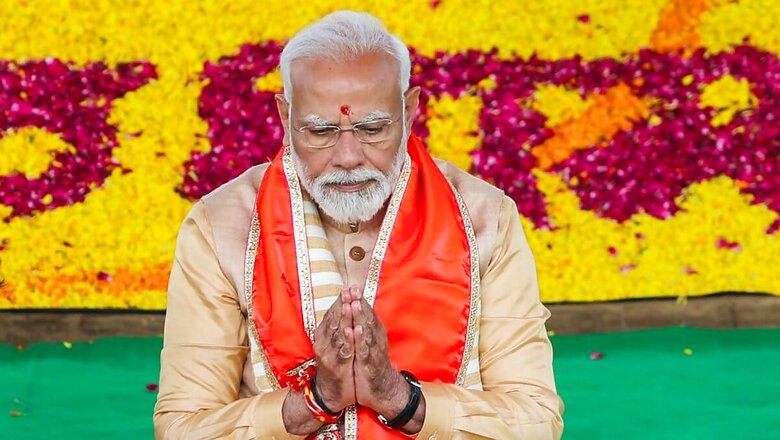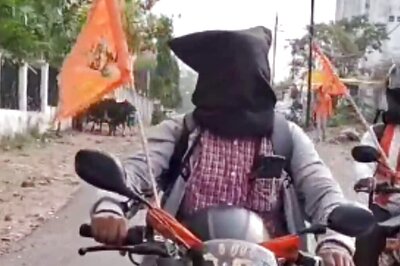
views
Prime Minister Narendra Modi remains to be the most popular leader nationally and internationally, according to Morning Consult, the global leader approval rating agency. He has earned the highest approval rating of any democratically elected leader in the world, at 78 per cent, as of November 2023. With an unwavering commitment to good governance, PM Modi has created a unique niche for himself by placing ‘vikas’ and ‘virasat’ together as the core twin agenda of his government.
A major achievement signifying ‘virasat’ is the consecration of the Ram Mandir in Ayodhya which is rightly addressed by the PM not as a source of social conflict, but as a source of social solution which will work as a repository of faith and goodwill of the Indians. PM Modi’s modus operandi essentially combines innovation, new ideas, steely political will and imaginative strategies in sync with a highly effective apparatus of governance, with ancient Indian traditional ethos centrally placed in the process of policy formulation and implementation.
The dictum, “where there is both Nîti (principle) and might, there is all round prosperity”, contained in the Śukranītisāra, a 4th Century AD text on the science of governance, applies the best to contemporary India under the Prime Ministership of Narendra Modi. With a commitment to inclusive growth and development, the Modi government has created a robust network of the country’s defence (both external and internal), stands tall as a stalwart in international diplomacy, has democratised the use of technology and innovation and has encouraged the implementation of empowering modern ideas at work. PM Modi has not only justified the political formulations contained in the ancient Indian treatises on statecraft and dharma but also has marshalled the skills and spirit of being a successful modern international leader (Vishwaguru). Thus, PM Modi becomes the epitome of Rājadharma and the ideal ruler as per the ancient Indian Hindu scriptures like the Mahābhārata and the Rāmayana et al.
PM Modi becoming the upholder of Rājadharma and perpetuating the establishment of the concept of a Rāmarājya, can be gleaned by an examination of the relevant portions of the Ṡāntiparva of the Mahābhārata, Ayodhyākānda of the Rāmayana vis-à-vis the model of governance under PM Modi. The Ṡāntiparva of the Mahābhārata, clearly indicates that the idea and the practice of politics cannot be divorced from ethics and rather both are inextricably linked with each other. Though the Mahābhārata did not deter a ruler the practice of real-politik strategies to be adopted for national interest and emphasised primarily on political power and military conquest. Lord Krishna essentially justifies the use of plans in the national interest and the inevitability of war in times of crises. Ṡāntiparva of the Mahābhārata, a discourse on statecraft conveyed by Bhishma to Yudhishthira, largely describes the functions and duties of a good ruler, both during normal times and a during period of emergency, finally signifying the importance of a welfarist model of state.
It, in the Dandaniti, Rājadharma, Ṡāsanapaddhati, Mantri Parishada and Kar-Vyavasthā, discusses at length the duties of the ruler and his system of governance. Bhishma’s discourse in the Ṡāntiparva is the most candid description of Rājadharma. While explaining Yudhishthira’s question pertaining to the duties of a ruler, Bhishma stated that “just as the rising sun scatters unholy darkness, so does Rājadharma destroy all evil significances in this world.” And further states that the ruler was the real executive. He has to perform the executive functions as established by dharma, including civil administration, military administration, judicial administration, fiscal administration and external affairs. The protection of all the Varnas constituted one of the important duties of the king along with the welfare of the people.
For the defence of the country and promotion of trade and commerce, easy means of communication are essential, so the ruler has to build roads throughout his territory. It is the king’s duty to help the subjects with financial assistance during drought, flood and famine. The Vedas, which are the supreme source of dharma, must be preserved by the ruler and in this process, he may punish those who create difficulties in the way of Vedic studies and their propagation. Rājadharma, according to the Mahābhārata, can be upheld through the government by maintaining peace, prosperity, law and order in the state, where the people can sleep peacefully and live fearlessly. Taking a reference from the Rāmāyana, Lord Rama’s emphasis on defence, finance and public relations can be gleaned from the following verses from the Ayodhya Kanda of the Rāmāyana, which is in the form of advice from the mouth of Rama to Guha, before the former leaves Ayodhya for exile. The verse goes like,
“apramattah bale kośe durge jana pade tathā
bhavethā guha rājyam hi durārakshatamam matam ||” (2-52-7)
(Translation: “Oh, Guha! Remain vigilant in defence, finance, internal security and public relations, for a kingdom is the most difficult one to be protected!”)
If we examine the model of governance and the policies of PM Narendra Modi and his concept of Amrit Kaal, outlining his vision for ‘New India’ by 2047, which was launched on the 75th Independence Day, one can understand how it is in consonance with these codes of the ancient Indian texts on statecraft and a welfarist model with modern innovations. This comprehensive plan aims to reshape India over the next 25 years, focusing on rapid profitable growth, improved living conditions, infrastructural advancements, and the restoration of global trust. Amrit Kaal strives to lay the foundation for a restructured Indian economy and society, emphasising inclusivity, technological progress, and sustainable development. The vision aspires to position India as a formidable global leader, addressing challenges and garnering international respect.
The Panch Pran of the Amrit Kaal are as follows:
- Goal of developing India.
- Elimination of any trace of the colonial mindset.
- Honour and pride in our roots.
- Development of unity.
- A sense of duty among the citizenry.
These initiatives under Narendra Modi’s leadership contribute to establishing a holistic, sustainable paradigm of development that transcends sectors and societal segments. While the vision aligns with international standards, it distinctly reflects India’s cultural essence, aiming to foster a profound sense of national pride among its citizens. Modi’s strategic approach involves transforming challenges into opportunities, steering India toward an intense and inclusive trajectory of development. This forward-looking, long-term perspective underscores the commitment to shaping a future that not only meets global benchmarks but also preserves and celebrates India’s ancient cultural heritage.
Economy: An unprecedented growth with inclusivity at the core
In 2013, Morgan Stanley identified India, among a group of vulnerable emerging-market economies, labelled as the “Fragile Five” for their over-dependence on foreign capital to fuel their economies along with huge current account deficits. After 10 years of the report and two consecutive terms of PM Modi, India stands firmly in the eyes of international investors and trading partners as one of the world’s fastest-growing large economies and a critical ‘China Plus One’ destination for companies seeking to reduce their exposure to political currents in Beijing.
Between 2014 and 2022, GDP grew at an average of 5.6 per cent in compound annual growth rate terms. An average of 14 other large developing economies had a CAGR of 3.8 per cent over the same period. Indian economy, in its Q3 assessment, FY 2023, registered a growth rate of 8.4 per cent, as a result of overall macro-economic stability, robust investment, moderate inflation within policy band, extensive and intensive CapEx by the government and other forums and delivery of the build-up projects within the stipulated time. The average real income has increased by 50 per cent.
Modi government has lifted 25 crore people out of multidimensional poverty and raised the living standards of 60 crore people. The share of India’s population living in extreme poverty has fallen from 18.7 per cent in 2015 to 12 per cent in 2021, according to the World Bank data. A total of 415 million people moved out of poverty in India within just 15 years from 2005/2006 to 2019/2021, as per the latest UN data and the international forum has called it a ‘remarkable achievement’ by the world’s most populous nation. Urban and rural regions both registered a drop in the share of people living below the international poverty line of $2.15 a day. India’s middle-income group, which can be slated between a family income of Rs 5,00,000- 30,00,000, has been among the fastest-growing economic group after the formation of the Modi government.
Moody’s Investors Service on March 7, 2024, announced that India is likely to remain the fastest-growing among G20 economies over their forecast horizon of 2024-25 with a continued robust economic growth which will further accelerate the real GDP growth from 7 per cent in 2022-23 to 8 per cent in 2023-24. The statistics ministry also raised its GDP growth estimate for FY24 to 7.6 per cent in its second revised estimate, up from 7.3 per cent in its first advance forecast. The Reserve Bank of India’s real GDP growth estimate for FY24 is 8 per cent, overshooting the NSO’s current estimate of 5.9 per cent in the final quarter, while the International Monetary Fund’s forecasts 6.7 per cent.
According to a Nasscom-Arthur D Little report titled, ‘Digital Public Infrastructure of India – Accelerating India’s Digital Inclusion’, Digital Public Infrastructure (DPI) is poised to propel India towards a $1 trillion digital economy by 2030, helping the country to become a $8 trillion economy. By 2030, DPI will significantly enhance citizens’ efficiency and promote social as well as financial inclusion, the report said. Mature DPIs such as Aadhaar, Unified Payments Interface (UPI), and FASTags have witnessed exponential adoption so far, the next seven to eight years offer an opportunity for further scalability, reaching even the most remote segments of the population.
A ramped-up infrastructure creation, both digital and physical, under the Modi government has taken place at a historically unprecedented rate, with an increase in overall public sector capital investment from Rs 5.6 lakh crore in FY15 to Rs 18.6 lakh crore in FY24, as per Budget estimates, accounting to 3.3X surge. Thus, bringing revolutionary transformations both in terms of the total length of highways, freight corridors, number of airports, metro rail networks, and the trans-sea-links. In the past 10 years, the total length of the national highways in the country has increased by about 59 per cent, and as a result of this expansion, India now has the second largest road network after the US. The IMF has recently appreciated India’s prospect of economic growth remaining strong, supported by macroeconomic and financial stability. It further predicted sustainable growth due to India’s strong DPI and physical infrastructure.
The decade-long Modi government’s policies bring effectively at work, the paradigm of inclusive growth which has been implemented through structural reforms, infrastructure creation, welfare programs aimed at benefiting the public, and creation of gainful employment generation. The most critical aspect of inclusive growth is financial inclusion which has been a core agenda and achievement of the Modi government.
To Be Continued
The author is a senior faculty in the Department of History, ARSD College, University of Delhi. Views expressed in the above piece are personal and solely that of the author. They do not necessarily reflect News18’s views.




















Comments
0 comment